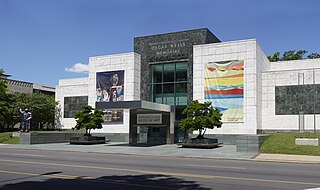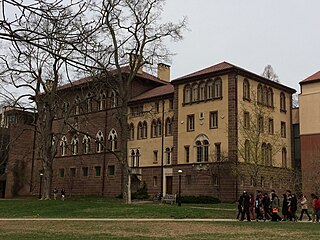Related Research Articles

The Scottish National Gallery of Modern Art is part of the National Galleries of Scotland, which are based in Edinburgh, Scotland. The National Gallery of Modern Art houses the collection of modern and contemporary art dating from about 1900 to the present in two buildings, Modern One and Modern Two, that face each other on Belford Road to the west of the city centre.

Carnegie Museums of Pittsburgh are four museums that are operated by the Carnegie Institute headquartered in the Carnegie Institute complex in the Oakland neighborhood of Pittsburgh, Pennsylvania. The Carnegie Institute complex, which includes the original museum, recital hall, and library, was added to the National Register of Historic Places on March 30, 1979.
Paul Jenkins was an American abstract expressionist painter.

Huntsville Museum of Art (HMA) is a museum located in Huntsville, Alabama. HMA sits in Big Spring Park within Downtown Huntsville, and serves as a magnet for cultural activities.

The Birmingham Museum of Art is a museum in Birmingham, Alabama. It has one of the most extensive collections of artwork in the Southeastern United States, with more than 24,000 paintings, sculptures, prints, drawings, and decorative arts representing numerous cultures, including Asian, European, American, African, Pre-Columbian, and Native American. Among other highlights, the museum's collection of Asian art is considered the finest and most comprehensive in the Southeast, and its Vietnamese ceramics one of the finest in the US. The museum also is home to a collection of Renaissance and Baroque paintings, sculpture, and decorative arts from the late 13th century to c.1750.
Philip Pearlstein is an American painter best known for Modernist Realism nudes. Cited by critics as the preeminent figure painter of the 1960s to 2000s, he led a revival in realist art. He is a Distinguished Professor Emeritus with paintings in the collections of over 70 public art museums.

The Museum of Contemporary Art Jacksonville, also known as MOCA Jacksonville, is a contemporary art museum in Jacksonville, Florida, funded and operated as a "cultural institute" of the University of North Florida. One of the largest contemporary art institutions in the Southeastern United States, it presents exhibitions by international, national and regional artists.

The Kalamazoo Institute of Arts (KIA) is a non-profit art museum and school in downtown Kalamazoo, Michigan, United States.

The Frances Lehman Loeb Art Center is a teaching museum, major art repository, and exhibition space on the campus of Vassar College, in Poughkeepsie, New York, United States. It was founded in 1864 as the Vassar College Art Gallery. It displays works from antiquity to contemporary times. Vassar was the first college or university in the country to include an art museum as part of its original plan. The current 36,000-square-foot (3,300 m2) facility was designed by César Pelli and named in honor of the new building’s primary donor Frances Lehman Loeb, a member of the Class of 1928.

The Museum of Art, Rhode Island School of Design is an art museum integrated with the Rhode Island School of Design, in Providence, Rhode Island, US. The museum was co-founded with the school in 1877, and still shares multiple buildings and facilities. It is the 20th-largest art museum in the United States, and has seven curatorial departments.

Michael Bidlo is an American conceptual artist who employs painting, sculpture, drawing, performance, and other forms of "social sculpture."

The Princeton University Art Museum (PUAM) is the Princeton University gallery of art, located in Princeton, New Jersey. Founded in 1882, it now houses over 92,000 works of art ranging from antiquity to the contemporary period. The Princeton University Art Museum dedicates itself to supporting and enhancing the University's goals of teaching, research, and service in fields of art and culture, as well as to serving regional communities and visitors from around the world. Its collections concentrate on the Mediterranean region, Western Europe, China, the United States, and Latin America.

The Rollins Museum of Art is located on the Winter Park campus of Rollins College and is the only teaching museum in the greater Orlando area. The museum houses more than 5,000 objects ranging from antiquity through contemporary eras, including rare old master paintings and a comprehensive collection of prints, drawings, and photographs. The museum displays temporary exhibitions on a rotating basis along with the permanent collection.

Art Museum of the Americas (AMA), located in Washington, D.C., is the first art museum in the United States primarily devoted to exhibiting works of modern and contemporary art from Latin America and the Caribbean. The museum was formally established in 1976 by the Organization of American States (OAS) as the Museum of Modern Art of Latin America. Artists represented in the AMA's permanent collection include Carlos Cruz-Diez, Candido Portinari, Pedro Figari, Fernando de Szyszlo, Amelia Peláez, and Alejandro Obregón.

The Snite Museum of Art is the fine art museum on the University of Notre Dame campus, near South Bend, Indiana. With about 30,000 works of art that span cultures, eras, and media, the Snite Museum's permanent collection serves as a rich resource for audiences on campus and beyond. Through programs, lectures, workshops, and exhibitions, the museum supports faculty teaching and research and provides valuable cultural opportunities for students and visitors. Students play an active role in programming in their capacities as gallery guides and as student advisory members.

Horace Day, also Horace Talmage Day, was an American painter of the American scene who came to maturity during the Thirties and was active as a painter over the next 50 years. He traveled widely in the United States and continued to explore throughout his life subjects that first captured his attention as an artist in the Thirties. He gained early recognition for his portraits and landscapes, particularly his paintings in the Carolina Lowcountry.

The Greenville County Museum of Art (GCMA) is an art museum located in Greenville, South Carolina. Its collections focus mainly on American art, and its holdings include works by Andrew Wyeth, Josef Albers, Jasper Johns, Andy Warhol, Romare Bearden, Jacob Lawrence, Ronnie Landfield, Helen Turner, Mary Tannahill, Eric Fischl, Marylyn Dintenfass, and Leon Golub. Southern American and South Carolina-based artists, such as Henrietta Johnston, are also represented.

Ezio Martinelli was an American artist who belonged to the New York School Abstract Expressionist artists, a leading art movement of the post-World War II era.

Daniel J. Robbins was an American art historian, art critic, and curator, who specialized in avant-garde 20th-century art and helped encourage the study of it. Robbins' area of scholarship was on the theoretical and philosophical origins of Cubism. His writings centered on the importance of artists such as Albert Gleizes, Jean Metzinger, Henri Le Fauconnier and Jacques Villon. He was a specialist in early Modernism, writing on Salon Cubists and championed contemporaries such as Louise Bourgeois and the Color Field painters. Art historian Peter Brooke referred to Robbins as "the great pioneer of the broader history of Cubism".

Henry Pearlman (1895–1974) was a Brooklyn-born, self-made businessman, and collector of impressionist and post-impressionist art. Over three postwar decades, he assembled a "deeply personal" and much revered collection centered on thirty-three works by Paul Cézanne and more than forty by Vincent van Gogh, Amedeo Modigliani, Chaïm Soutine, Paul Gauguin, Édouard Manet, Henri de Toulouse-Lautrec and a dozen other European modernists.